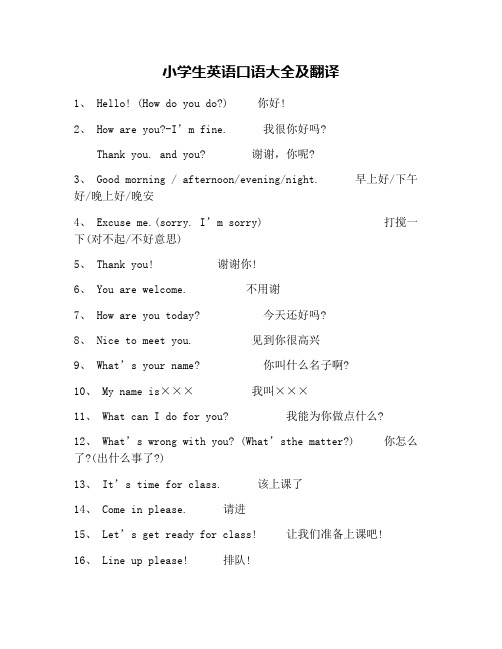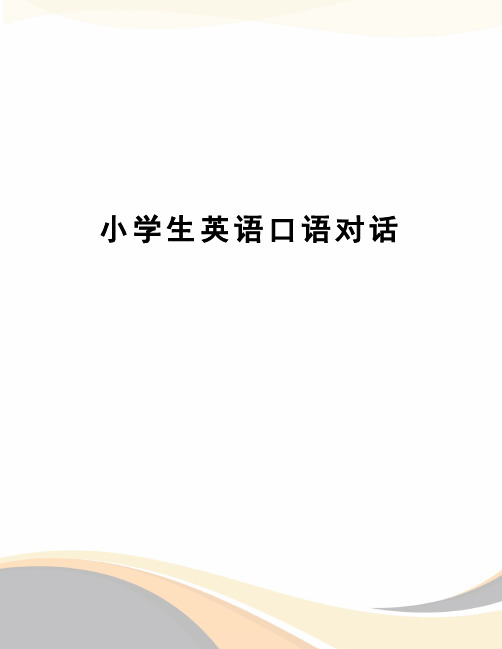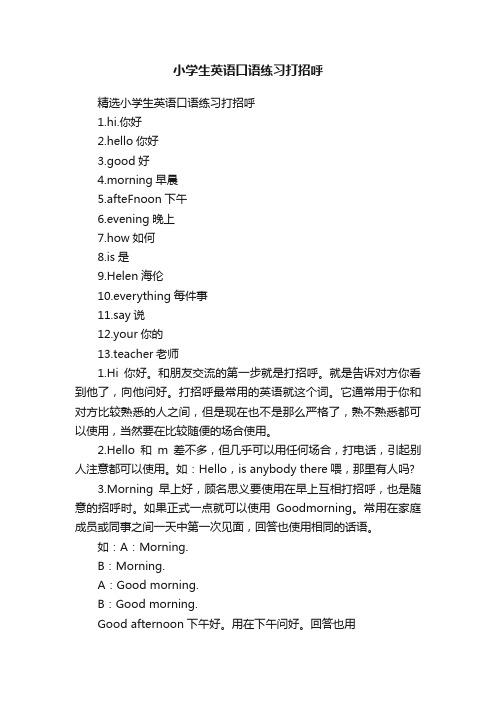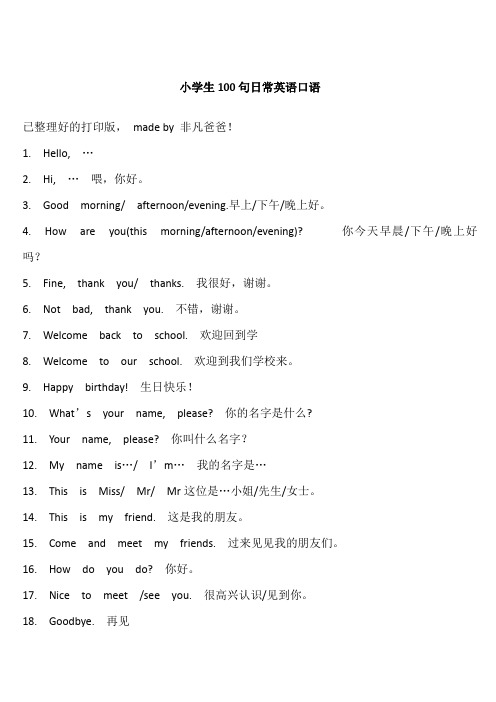小学生英语口语课件
小学生英语口语大全及翻译

小学生英语口语大全及翻译1、 Hello! (How do you do?) 你好!2、 How are you?-I’m fine. 我很你好吗?Thank you. and you? 谢谢,你呢?3、 Good morning / afternoon/evening/night. 早上好/下午好/晚上好/晚安4、Excuse me.(sorry. I’m sorry) 打搅一下(对不起/不好意思)5、 Thank you! 谢谢你!6、 You are welcome. 不用谢7、 How are you today? 今天还好吗?8、 Nice to meet you. 见到你很高兴9、What’s your name? 你叫什么名子啊?10、My name is×××我叫×××11、 What can I do for you? 我能为你做点什么?12、What’s wrong with you? (What’sthe matter?)你怎么了?(出什么事了?)13、It’s time for class. 该上课了14、 Come in please. 请进15、Let’s get ready for class!让我们准备上课吧!16、 Line up please! 排队!17、 Attention please! 立正!18、 At ease. 稍息19、 Turn life/right! 向左/右转!20、 One bye one please.no pushing. 一个一个来,不要挤【篇二】1、 What are you going to do tonight? 今晚干啥去?2、I’m going to Disney’s English Club. 我要去迪士尼英语俱乐部3、I’m going to learn Disney’s Magic English. 我去学迪士尼神奇英语4、What’s on tonight? 今晚有什么节目?5、Let’s watch TV. 我们看电视吧!6、We are going to the Pople’s Prk. 我们要去人民公园7、 Be quiet.please. 请安静8、Stop talking!(Do’t talk.) 别讲话9、Don’t worry about it. 不要为这担心10、 No problem. 没问题11、 Clap your hands. 鼓撑拍手12、 Class is over.(Time is up.) 下课了!(时间到了)13、 See you next time.Bye bye! 下次见,再见14、 Well done! 干得好!15、 You are so smart! 你真聪明!16、 How clever you are! 你真是太聪明了!17、Let’s have a rest.(take a break) 我们休息一下18、 It’s time to go to bed. 该睡觉了19、It’s time to get up.(Wake up.please.) 该起床了(醒醒)20、 Wash your face/hands/foot. 洗脸/手/脚【篇三】1、 Comb your hair. 梳头2、 Brush your teeth. 刷牙3、Come on.Let’s play together. 过来,我们一起玩4、Let’s play a game. 我们来玩个游戏。
小学生英语口语对话

小学生英语口语练习经典对话一、交1.Hello, ⋯你好。
Hi,⋯喂,你好。
3.Goodmorning/afternoon/evening.早上/下午/晚上好。
4.Howareyou(thismorning/afternoon/evening)?你今天好?5 .Fine,thankyou/thanks.我很好,。
6.Notbad,thankyou.不,。
7 .Welcomebacktoschool.迎回到学校来。
8.Welcometoourschool.迎到我学校来。
Happybirthday!生日快!What’syourname,please?你的名字是什么?Yourname,please?你叫什么名字?Mynameis⋯/I’m⋯我的名字是⋯/我名叫⋯ThisisMiss/Mr/Mrs⋯位是⋯小姐/先生/女士。
Thisismyfriend.是我的朋友。
1eandmeetmyfriends.来我的朋友。
16.Howdoyoudo?你好。
17.Nicetomeet/seeyou.很高/到你。
Goodbye.再Goodnight.晚安。
Howoldishe?他多大了?21.Thankyou./Thanks. 。
You’rewelcome.不用。
That’sallright.没关系。
I’msorry.不起。
Sorry,Idon’tknow.不起,我不知道。
Excuseme.不起,打一下。
2ein,please.。
28.Havesomebananas,please.吃些香蕉。
It’stimeforthecakes.吃些蛋糕了。
MayIcomein?我可以来?MayIhaveyours?我能吃你的?CanIhavetwocakes?我能吃两个蛋糕?No,youcan’t.不,你不能。
CanIhaveone,please?我能吃一个?36.Yes./Allright.Hereyouare. 好的。
你。
CanIgowithyou?我能和你一起走?Sure.好的。
新人教版三年级上册英语情景对话复习课件ppt

A. Can I have some milk? B. Can I have some water? C. Can I
have some rice? ( B ) 12. 你想让对方吃这个蛋糕时,你会对他说: A. That one, please.B. Eat some cake, please.C. Eat some
AC. Here you are
( ) 15. 今天是丽丽的生日,同桌会对她说:
为深入学习习近平新时代中国特色社 会主义 思想和 党的十 九大精 神,贯彻 全国教 育大会 精神,充 分发挥 中小学 图书室 育人功 能
( C ) 16. 你和爸爸一起去公园散步,你们遇见了你的班主任孙老 师,你会向爸爸介绍孙老师说: A. Hello, Mr Sun. B. Bye, Mr Sun. C. This is Mr Sun.. ( B) 17. 下午好。 A. Good morning. B. Good afternoon C. Goodbye. ( B) 18. 这是李小姐。 A. That is Miss Li. B. This is Miss Li. C. It’s Miss Li. ( A ) 19. 切蛋糕。 A. Cut the cake. B. Drink some water. C. Eat some fish. ( C ) 20. 不用谢。 A. Thank you. B. I like it. C. You’re welcome.
coAke. ( ) 13. 一位老奶奶摔倒了,你将她扶起来,她会对你说:
BA. Thank you. B. Nice to meet you. C. You’re welcome. ( ) 14. 你刚刚跑完步回来,你很渴,你会对妈妈说:
小学生英语口语对话

小学生英语口语对话小学生英语口语对话公司内部档案编码:[OPPTR-OPPT28-OPPTL98-OPPNN08]小学生英语口语练习经典对话一、交际1. Hello, …你好。
2. Hi, …喂,你好。
3. Good morning/ afternoon/evening. 早上/下午/晚上好。
4. How are you(this morning/afternoon/evening) 你今天好吗5. Fine, thank you/ thanks. 我很好,谢谢。
6. Not bad, thank you. 不错,谢谢。
7. Welcome back to school. 欢迎回到学校来。
8. Welcome to our school. 欢迎到我们学校来。
9. Happy birthday! 生日快乐!10. What’s your name, please 你的名字是什么11. Your name, please 你叫什么名字12. My name is…/ I’m…我的名字是…/ 我名叫…13. This is Miss/ Mr/ Mrs…这位是…小姐/先生/女士。
14. This is my friend. 这是我的朋友。
15. Come and meet my friends. 过来见见我的朋友们。
16. How do you do 你好。
17. Nice to meet /see you. 很高兴认识/见到你。
18. Goodbye. 再见19. Good night. 晚安。
20. How old is he 他多大了21. Thank you./ Thanks. 谢谢。
22. You’re welcome. 不用谢。
23. That’s all right. 没关系。
24. I’m sorry. 对不起。
25. Sorry, I don’t know. 对不起,我不知道。
26. Excuse me. 对不起,打扰一下。
小升初英语口语话题ppt课件

你最喜欢的季节是什么?
• My favorite season is summer. It’s hot in summer. I think many children like this season, because they can eat ice-cream and go swimming. I can go swimming ,too. Sometimes I go too the beach with my parents. Sometimes I go to the swimming pool with my friends. I usually visit many places in summer vacation.
•
用英语介绍一下你的父亲。
• My father is 40 years old. He is tall and strong. He likes playing sports very much. He often plays basketball with me on weekends. He is a teacher. He teaches English. He loves his students very much.
你最喜欢的节日是什么?
• My favorite festival is the Spring Festival. In the Spring Festival, I can play with my friends. I can eat a lot of delicious food. I can get some lucky money. We have a special meal. It’s a big family dinner. I love Spring Festival.
小学口语交际ppt课件

口语交际是人与人之间情感交流的重要方式,通过口语交际,学生能 够更好地理解他人的情感和需求,增强自己的人际交往能力。
提高综合素质
口语交际能力是学生综合素质的重要组成部分,良好的口语交际能力 能够为学生未来的学习和工作打下坚实的基础。
口语交际与书面交际的区别
形式不同
口语交际是以口头语言的形式 进行,而书面交际是以文字的
加强口语训练
组织口语活动
定期组织口语角、演讲比赛等活动, 鼓励学生积极参与。
提供口语练习材料
提供丰富的口语练习材料,如故事、 对话等,让学生有更多机会练习。
强化语音、语调训练
注重纠正学生的发音、语调,培养良 好的语言习惯。
鼓励孩子多说话
鼓励主动发言
在课堂上鼓励学生主动发 言,表达自己的观点和想 法。
REPORT
CATALOG
DATE
ANALYSIS
SUMMAR Y
04
小学口语交际的练习方 法
朗读练习
总结词
通过朗读练习,学生可以提高口语表 达的流畅性和准确性。
详细描述
朗读练习可以帮助学生熟悉语言结构 ,掌握正确的发音和语调,同时也有 助于培养学生的语感和表达能力。
角色扮演
总结词
角色扮演是一种有效的口语交际练习方法,可以帮助学生更好地理解语境和人 物关系。
形式进行。
语境不同
口语交际的语境是即时的、现 场的,而书面交际的语境是延 时的、非现场的。
表达方式不同
口语交际的表达方式是语音、 语调和肢体语言等,而书面交 际的表达方式是文字和标点符 号等。
目的不同
口语交际的目的是为了沟通、 交流和表达思想情感,而书面 交际的目的是为了传递信息和
小学生英语口语练习打招呼

小学生英语口语练习打招呼精选小学生英语口语练习打招呼1.hi.你好2.hello你好3.good好4.morning早晨5.afteFnoon下午6.evening晚上7.how如何8.is是9.Helen海伦10.everything每件事11.say说12.your你的13.teacher老师1.Hi你好。
和朋友交流的第一步就是打招呼。
就是告诉对方你看到他了,向他问好。
打招呼最常用的英语就这个词。
它通常用于你和对方比较熟悉的人之间,但是现在也不是那么严格了,熟不熟悉都可以使用,当然要在比较随便的场合使用。
2.Hello和m差不多,但几乎可以用任何场合,打电话,引起别人注意都可以使用。
如:Hello,is anybody there喂,那里有人吗?3.Morning早上好,顾名思义要使用在早上互相打招呼,也是随意的招呼时。
如果正式一点就可以使用Goodmorning。
常用在家庭成员或同事之间一天中第一次见面,回答也使用相同的话语。
如:A:Morning.B:Morning.A:Good morning.B:Good morning.Good afternoon下午好。
用在下午问好。
回答也用Good afternoon.Good evening.晚上好。
用于晚上问好。
回答也用Good evening.这几个招呼的.回答都用同一个词,对方怎样和你招呼,你就和对方怎样招呼:对方说m,你就说Hi;对方说Hello,就说Hello;对方说Morning,你就说morning;对方说good morning你就说good morning.不会错的。
4.How are you你好。
也非常口语化,常常用在I{i,Heuo之后。
如:Oh,hi,Mary!How are you?噢,玛丽,你好。
How are you的回应更常见的是用Fine,或I'm fine.通常还要紧接一句感谢,thank you.How is Helen.海伦好吗?是向第三方问候,回答当然也要用第三方打头:She is well.5.How do you do?你好。
小学生100句日常英语口语(打印版)

小学生100句日常英语口语已整理好的打印版,made by 非凡爸爸!1.Hello,…2.Hi,…喂,你好。
3.Good morning/afternoon/evening.早上/下午/晚上好。
4.How are you(this morning/afternoon/evening)?你今天早晨/下午/晚上好吗?5.Fine,thank you/thanks.我很好,谢谢。
6.Not bad,thank you.不错,谢谢。
7.Welcome back to school.欢迎回到学8.Welcome to our school.欢迎到我们学校来。
9.Happy birthday!生日快乐!10.What’s your name,please?你的名字是什么?11.Your name,please?你叫什么名字?12.My name is…/I’m…我的名字是…13.This is Miss/Mr/Mr这位是…小姐/先生/女士。
14.This is my friend.这是我的朋友。
e and meet my friends.过来见见我的朋友们。
16.How do you do?你好。
17.Nice to meet/see you.很高兴认识/见到你。
18.Goodbye.再见19.Good night.晚安。
20.How old is he?他多大了?21.Thank you./Thanks.谢谢。
22.You’re welcome.不用谢。
23.That’s all right.没关系。
24.I’m sorry.对不起25.Sorry,I don’t know.对不起,我不知道。
26.Excuse me.对不起,打扰一下。
e in,please.请进。
28.Have some bananas,please.请吃些香蕉。
29.It’s time for the cakes.该吃些蛋糕了。
30.May I come in?我可以进来吗?e in,please.请进。
- 1、下载文档前请自行甄别文档内容的完整性,平台不提供额外的编辑、内容补充、找答案等附加服务。
- 2、"仅部分预览"的文档,不可在线预览部分如存在完整性等问题,可反馈申请退款(可完整预览的文档不适用该条件!)。
- 3、如文档侵犯您的权益,请联系客服反馈,我们会尽快为您处理(人工客服工作时间:9:00-18:30)。
Log
Sit on
原木
列席
unit two Five Little Speckled Frogs
单词认知
歌词 视频 小组练习 小组展示
Five Little Speckled Frogs 歌词
FIVE little speckled frogs, Sat on a speckled log, Eating some most delicious bugs - yum, yum! One jumped into the pool, Where it was nice and cool, Then there were FOUR speckled frogs - glug, glug! FOUR little speckled frogs, Sat on a speckled log, Eating some most delicious bugs - yum, yum! One jumped into the pool, Where it was nice and cool, Then there were THREE speckled frogs - glug, glug!
unit two Five Little Speckled Frogs
单词认知
歌词 视频 小组练习 小组展示
unit two Five Little Speckled Frogs
单词认知
歌词 视频 小组练习 小组展示
小学生 英语口语
五邑大学 四三零课堂 课件
unit two Five Little Speckled Frogs
单词认知
歌词 视频 小组练习 小组展示
单词认知
Specklቤተ መጻሕፍቲ ባይዱd Frog 有斑点的 青蛙
cool
Bug Eat
凉爽的
虫子 吃
Delicious
Jump into Nice
美味的
跳进 好的
Five Little Speckled Frogs 歌词
TWO little speckled frogs, Sat on a speckled log, Eating some most delicious bugs - yum, yum! One jumped into the pool, Where it was nice and cool, Then there was ONE speckled frog - glug, glug! ONE little speckled frog, Sat on a speckled log, Eating some most delicious bugs - yum, yum! He jumped into the pool, Where it was nice and cool, Then there were NO speckled frogs.
